Spanish and Portuguese Wines
27th May 2003 - 3rd June 2003
|
|
|
|
|
|
Ribera del Duero, Spain
 |
For me, the Ribera del
Duero is one of the most exciting wine-producing regions of Spain.
It lies due north of Madrid and just to the East of Valladolid in the valley of the River Duero in Castille.
Growing grapes, or at least making wine is a relatively new activity in the
area, and the Denominacion de Origen Ribera del Duero was only created in
1982 and covers around 11,500 hectares. The first vineyards were established more or less at the same
time as those of Rioja, by the Bordelais fleeing the phylloxera that was
devastating French vineyards in the middle of the 19th century. |
|
One of the first estates was planted in Valbuena de Duero in 1864 at the Pago de la Vega Santa Cecilia y Carrascal. In time this name was abbreviated to 'Vega Sicilia'. But the region was slow to take up viticulture. Travelling around Ribera del Duero and surrounding areas, it's clear that much of the land is still used for more traditional agriculture - sugar beet, cereals and vegetables - or simply fallow. But the area under vines is growing, and everywhere you look there are new vineyard plantings. The region was also slow to gain its reputation in the wine world. Vega Sicilia was established and revered. But perhaps the breakthrough came when the American critic, Robert Parker knelt down and worshipped at the foot of Alejandro Fernandez, whose 1986 Pesquera he called the Petrus of Spain. Naturally, this led to a lot of investment, particularly from those sensing a fast buck to be made. Even today there's a fair bit of rubbish produced, but overall standards are rising, especially as the top producers expand their operations. Thus Alejandro Fernandez now has operations at Condada de Haza in the Ribera del Duero D.O. as well as El Vinculo in La Mancha and Dehesa La Granja in Toro. Vega Sicilia also now have a winery in Toro at San Román (though Bodegas Mauro beat them to the San Román name for the wine), and the Sanz family have opened wineries in Toro and the Ribera del Duero (Bodegas Toresanas and Bodegas Vallebueno respectively). Driving through the Ribera countryside, it is evident that there is much new planting happening, alongside the cereals that still seem to form the bulk of the crop. "Ribera del Duero" means the banks of the Duero, and the great river Duero, which becomes the Douro when it enters Portugal, naturally has a huge role to play in the landscape and climate. But it is odd, how little one sees of the river. Driving around, the impression is often of being on a continental plain, though hills are never far away, often taking the form of limestone outcrops: the most notable perhaps being that on which the castle of Penafiel is perched. The limestone outcrops indicate the determining geology of the region: clay and limestone topsoils, with up to 18%-20% active lime in the soil, on a schist subsoil, with more alluvial deposits on the river plain itself. The climate is a continental climate, exacerbated by the altitude (c. 750m - 850m above sea level). It is very hot and dry in the summer and bitterly cold in the winter, with a huge diurnal temperature variation of up to 20°C in the summer, when daytime temperatures easily reach 30-40°C. Frosts are common as late as May and as early as October. The River Duero can moderate this, but the vineyards tend to be planted away from the richest soils of the alluvial plain, as vines prefer poorer soils. The low night-time temperatures during the summer lead to the vines closing down overnight - almost going into hibernation - and only coming back to life during the hot daylight hours. This means that the vines are slower to grow and longer to ripen than might be expected: harvest can be as late as October at some estates. The principal grape, occupying around 85% of the Ribera's vineyards, is tempranillo, or at least a variant known here as tinto fino or tinto del pais. Some more international red varieties are grown (mainly cabernet sauvignon, but merlot also makes an appearance here and there). This is a red wine region, with no whites produced, although a native white grape, the Albillo, is permitted by the DO regulations: it is blended judiciously into some reds, but is also used in the blending of the regions rosado wines. In general there are four grades of wine produced: vin joven; crianza; reserva; gran reserva. Some estates will also produce a reserva especial, which are not controlled by the Denominacion de Origen rules, but are generally are gran reservas or better: in the case of Vega Sicilia they are non-vintage wines produced by blending gran reservas from the best years.
|
|
A pleasant flight to Madrid, followed by a drive to the Ribera del Duero brought me to my base for the next few days at the comfortable if unexceptional Hotel Tudanca at Fuentespina near Aranda de Duero. We punctuated the drive with a little "light" luncheon at an unknown restaurant in an unknown small town about 15 - 20 minutes north of Madrid on the drive from Madrid airport to Aranda de Duero.
-
As we entered the restaurant, we were immediately assailed by smoke. Not from the Spanish men, propping up the bar, but from a wood or charcoal oven somewhere on the premises. The bar area was dark and atmospheric. Hams, hams and more hams hung above the bar. Several bottles of something red, probably a basic crianza from the Ribera del Duero appeared, but I didn't note down what it was. Dishes of olives and nuts circulated with the bottles.
After a while, and having polished off all the wine, we were ushered through into an airy, bright dining room, passing on the way a hatch into the kitchen. Piled by the hatch were numerous large dishes containing what looked like roadkill pigs: these were suckling pigs and suckling lambs that had been spatchcocked and roasted.
Main course simply had to be some of this fabulous suckling pig and chips. The chips were purely coincidental: the suckling pig was the star. As tender as butter, sweet, moist and totally delicious. Of course, before that we had to make our way through trays of tapas style appetisers. There were lots of salads (too much salad, really), with white asparagus much in evidence. Of the hot appetisers, some red peppers stuffed with squid and served with a jet black sauce made from the squid ink was excellent, scrambled eggs with morcilla was superb (and now oft repeated at home), but all was overshadowed by some amazingly delicious suckling lamb kidneys, plainly roasted, apparently in what suet that they had at that tender age developed. Quite delicious.
With excellent coffee, the bill came to €40 per person. The restaurant provided two carafes of ice cold grappa style firewater. One was almost safe to drink, the other, a fluorescent lime green colour, appeared to be distilled from toothpaste and was utterly nasty.
With lunch we had the following two wines (as they were drunk over lunch, there is no detailed note)
-
1999 Protos Crianza
Very dull nose at first, but opened up nicely. Very rounded and open. Good. -
1996 Torremilanos Reserva , Bodega Penalba Lopez
Weedy initially. Opens up well, but still oddly thinner and lighter than the Protos. After being open a while and with some air swirled into it, it developed some nice fruit. Good, but unexceptional.
-
-
Pesquera and Condado de Haza tasted at Condado de Haza
The Condado de Haza estate lies close to the town of Haza in the Ribera del Duero and has 200 hectares of tempranillo. It is a relatively new estate bought by Alejandro Fernandez in the 1980s, the first 80 hectares being planted in 1989. The first commercial vintage was in 1994, although that was vinified at Pesquera.
Since 1995, however, Condado de Haza has had its own winery, and now the wine goes from vine to bottle all on the Condado de Haza estate. As elsewhere in the region Spanish and EU funding has been used to promote the eno-tourist economy, and the winery now includes a visitor centre, and a hotel was under construction on the site when I visited.
For the eponymous Condado de Haza wines, the grapes are de-stemmed and fermented in the Grupo Pesquera's hallmark home-made stainless steel vats, using natural yeasts only.

Alejandro Fernandez
Photo from publicity materials on Grupo Pesquera websitesThe wine then remains in stainless steel tanks for around twenty days before being aged in American oak barrels for 15 months. It then spends a further eight months in bottle before being released for sale. The Alenza cuvée, however, a premium wine which is also produced at Haza, uses a whole bunch fermentation of particularly ripe grapes and after vinification is racked several times into increasingly older barrels (American oak still) and kept in oak for 30 months. Alejandro Fernandez regards the Alenza as one of his greatest wines and celebrates his marriage to Esperanza. (Alejandro and Esperanza - geddit?)
All the wines made at Haza are bottled without filtration or fining.
Before our tasting over dinner, we had the obligatory tour round the winery: so you might as well too. Adjacent to the winery is the barrel store:

As you can see, it is entirely above ground, yet manages to maintain a stable temperature, though it certainly felt rather warmer than what we're led to believe is ideal cellar temperature once we've bought the bottled product! Curiously one way they say they keep it cool is to open all the doors and windows when it's cold at night. Again, inducing that sort of diurnal temperature variation is completely contrary to what we're supposed to do once we've got the stuff at home.
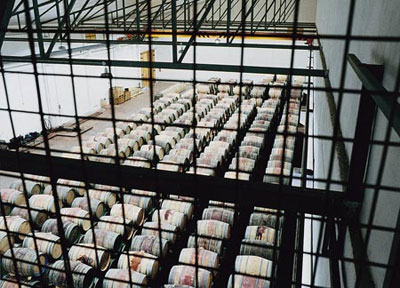
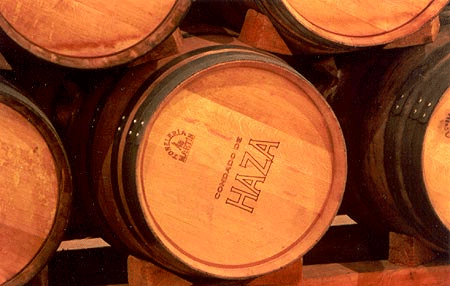
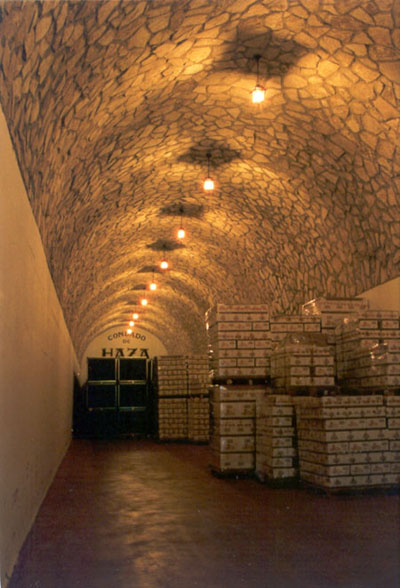
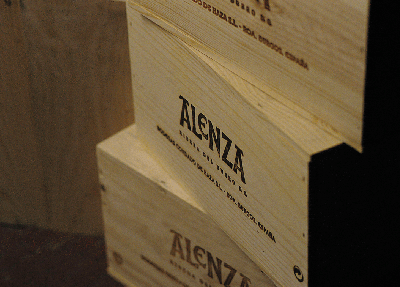
Photos from publicity materials on Grupo Pesquera websites
Above the winery, up a rather grand staircase, is a formal dining room, in which we huddled on one side for dinner and a tasting of a representative selection of wines from the Grupo Pesquera.
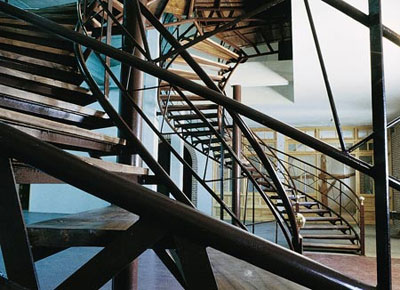
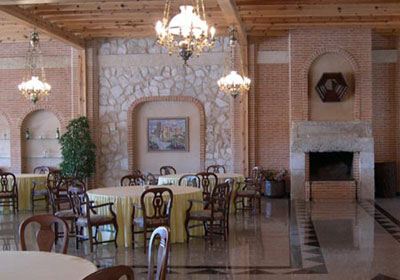
-
1999 Dehesa La Granja
This a Vino da Mesa from Toro. The estate in Zamora, Alejandro's third winery, has around 250 hectares under vine, all tempranillo.
The wine spends two years in new American oak and a further six months in bottle before release. 1999 is the second vintage.
It is very dark and young. A big, full fruity nose. Good fruit attack. Full and rich on the palate with a nice tannic structure. For me, it seems a slightly internationalised style: a very good, relatively basic tempranillo; not a lot of elegance, but attractive, if you like lots of oak. Very Good.
The wine was served with some excellent, abundant charcuterie.

-
2000 El Vinculo Crianza, La Mancha D.O.
The Bodega El Vinculo in La Mancha is Alejandro's latest venture: the first vintage was the 1999. La Mancha is an upcoming area in Spain, with even more of a continental climate that the Ribera del Duero: more sun, hotter temperatures, drier, but the same cold night and very cold winters: in La Mancha summer temperatures can climb to 45°C and plummet to -15°C in the winter. The area is very dry with an annual rainfall of no more than 400mm, often with prolonged periods of drought.
100% Tempranillo again, but this time from bought-in grapes: bought, it is worth noting, by the hectare, not by weight, which helps to ensure quality fruit. After vinification, the wine spends 16 months in oak and another 6 in bottle.
A very unusual nose: very fragrant, with tobacco and violets dominating, but also an eau de vie and burnt touch. Good full attack. Quite sweet; very full and round. Quite a big structure, but not at all tannic, just a nice soft roundness. Very pleasant finish. Very Good Indeed.
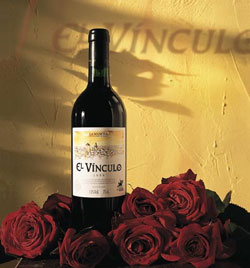
-
1996 Condado de Haza Ribera del Duero D.O.
A light elegant nose. Good attack. Very elegant. But I can't say I'm very impressed by this. It seems to lack fruit and character, with the tannins merely making the wine twiggy.
A second bottle, by contrast had a much more mushroomy nose, lacking the elegance of the first bottle and was generally poorer. OK.
For notes on the 2000 Condado de Haza click here.

-
1995 Alenza
The premium cuvée from Condado de Haza. A rather dark colour. Rich nutty nose, though rather spirity. Lovely attack. Smooth. Rich. Full. Very notably tannic. Big and powerful. Very Good Indeed.
Served with some lovely roast milk-fed lamb, from (vegetarians please look away) unweaned lambs under six weeks old.
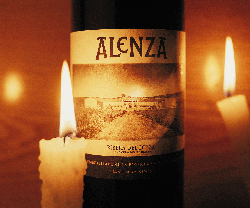
-
1996 Tinto Pesquera Gran Reserva (en magnum)
Rather closed fruit nose: plummy with a hint of spirit. Far too young. Fairly light on the attack. Very full on the palate with big tannins, though the tannins are not overwhelming. Full and clean, but very closed and quite green, especially on the finish. Will be superb, but this was as a bad a case of infanticide as those six week old lambs.
Remarkable, really, that they decided to serve this - all the more bizarre that they chose to serve magnums.
Served with cheese
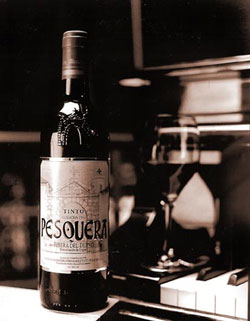
-
-
Vega Sicilia
For the full story on my visit to Vega Sicilia and tasting notes on the following wines, see my essay on the Myth and Reality of Vega Sicilia, available by following this link
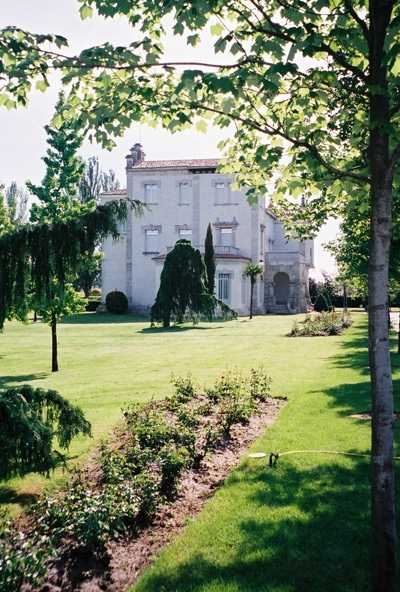
-
Abadia Retuerta
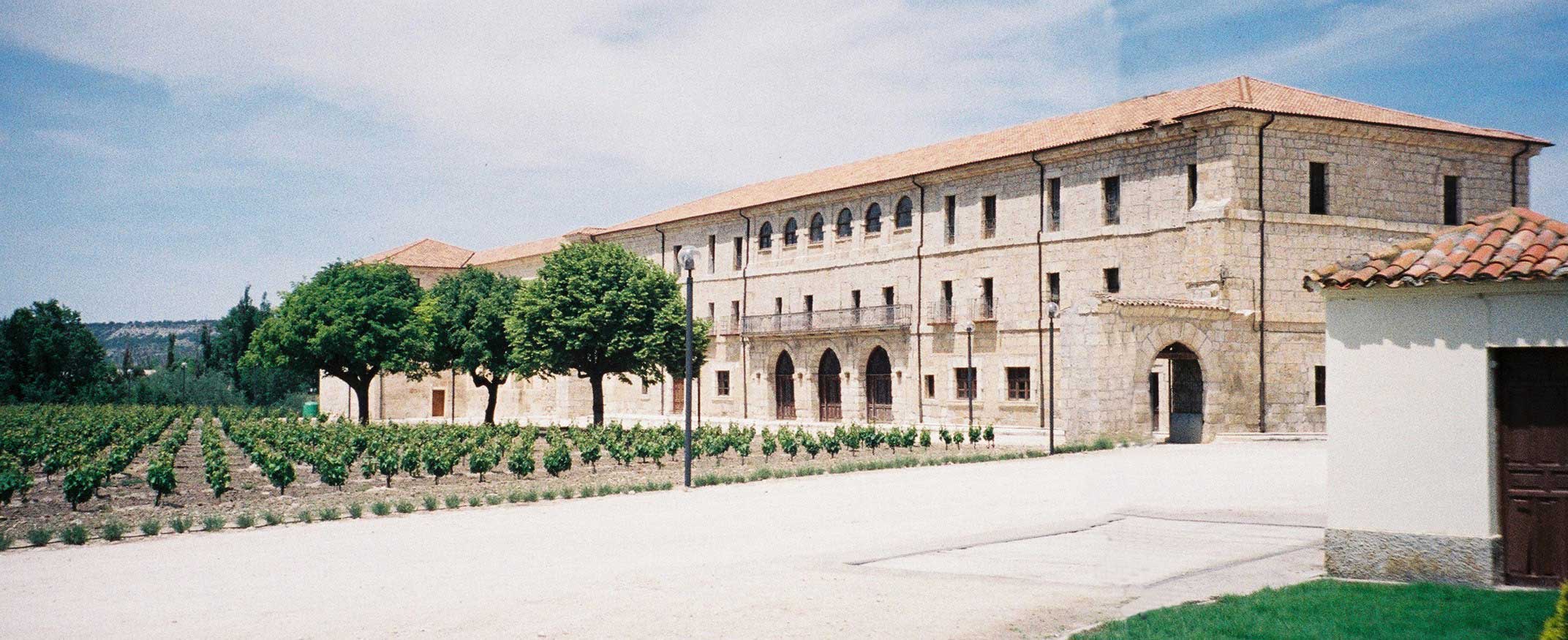 Lying
just outside the Ribera del Duero Denominacion de Origen area, Abadia
Retuerta is a relatively new winery, its first commercial production being
in 1996. The winery is situated on the 700 hectare estate of Santa
María de Retuerta in Sardón del Duero. The estate and winery is owned by the
Swiss pharmaceutical giant Novartis, who have clearly sunk some serious
money into it and engaged the services of Pascal Debeck, winemaker at
Chateau Belair in St Emilion, as consultant winemaker here. Sardón del
Duero is not yet an officially recognised DO, so the wines are sold as Vino de
la tierra: this may change, as the expansive Vega Sicilia have apparently
also started up an operation in Sardón, and are looking to have the area
elevated to DO status.
Lying
just outside the Ribera del Duero Denominacion de Origen area, Abadia
Retuerta is a relatively new winery, its first commercial production being
in 1996. The winery is situated on the 700 hectare estate of Santa
María de Retuerta in Sardón del Duero. The estate and winery is owned by the
Swiss pharmaceutical giant Novartis, who have clearly sunk some serious
money into it and engaged the services of Pascal Debeck, winemaker at
Chateau Belair in St Emilion, as consultant winemaker here. Sardón del
Duero is not yet an officially recognised DO, so the wines are sold as Vino de
la tierra: this may change, as the expansive Vega Sicilia have apparently
also started up an operation in Sardón, and are looking to have the area
elevated to DO status.Of the 700 hectares (1700 acres) of the whole estate, some 204 (500 acres) are under vines. 65% of the estate is planted with Tempranillo, 25% with Cabernet Sauvignon and 10% with Merlot and there are also amounts of Syrah and Petit Verdot. In all there are 54 separate plots, planted with the varieties most appropriate to the individual terroir of each plot. Each plot is then vinified separately, allowing them to make the best selections for the final blends of wines, although there are a small number of - high price - single plot wines made also.

There is a curious mix of the old and the new at Abadia Retuerta. Elsewhere this mix often seems to lead to tension, but here it all fits seamlessly. On the one hand, the abbey and monastery date back to the 12th century; on the other, the winery, located a short distance away, is very modern and appears, on the face of it, very high-tech. The vineyards have all sorts of systems to measure and control water stress (such as soil hygrometers, trunk expansion, leaf water potential, etc). Before picking, says the winery's website, "more than 2,000 analyses are conducted in order to determine the quality of the grapes in each plot". Among the data analysed are: "the weight of 100 grapes (which is an indicator of the adequate hydric stress control of the vine), the evolution of the grapes’ colour and tannins (monitoring of phenolic ripeness), as well as the measuring of classical parameters, i.e. acidity and alcohol level." I do wonder how much the fact that the owners are a Swiss pharmaceutical company influences this remarkable level of testing. Going into the winery itself, a huge (10,000 square metre) structure, built in 1996 and cut into the hillside, the impression is also of everything being very high tech.
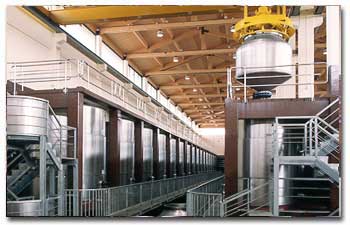
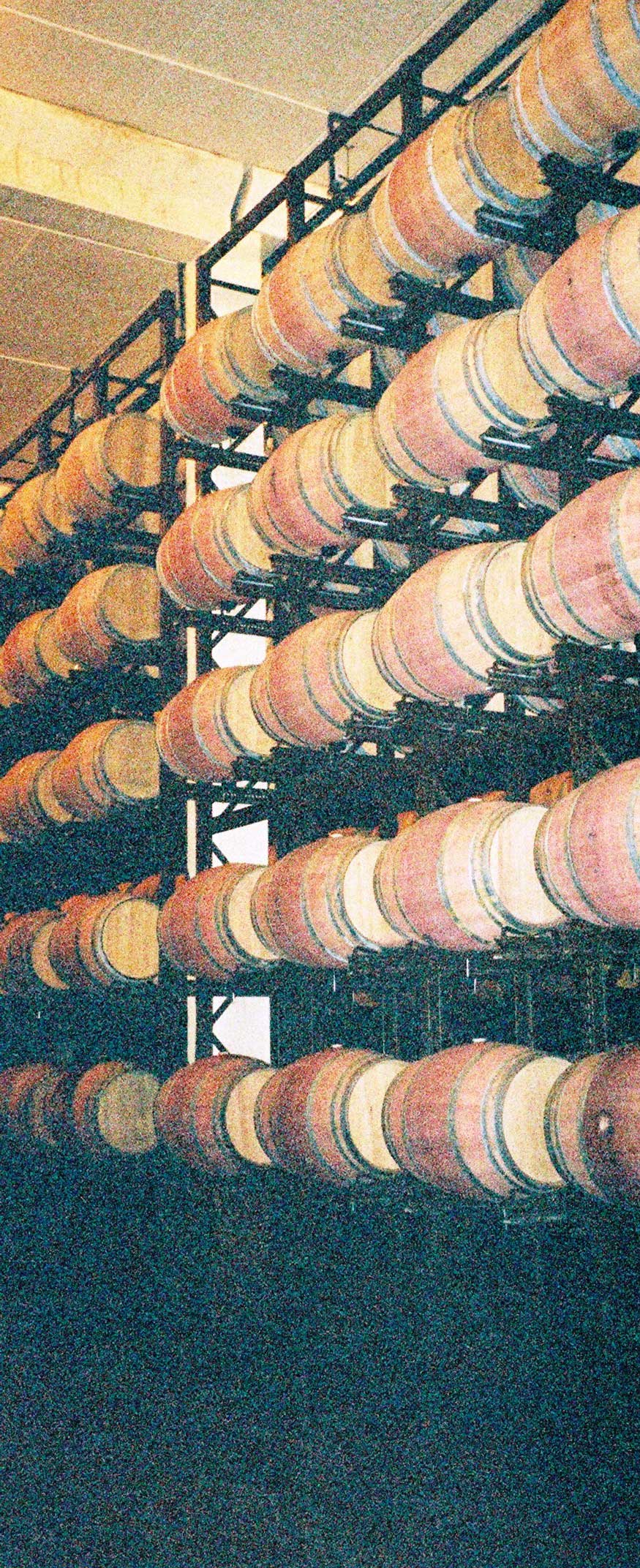
In the photograph left, it is possible to see some of the many stainless steel vinification tanks (there are more rows of tanks, to allow for plot-by-plot vinification), but also, apparently floating curiously mid-air top right, is one of their "ovis". These egg-ufos are key to what they regard as one of their most significant innovations: the introduction of gravity-flow vinification. From the moment the grapes are deposited for crushing, the juice and subsequent wine is moved only by gravity, not pumps as would be commonly found elsewhere. Each ovi (?) holds 6000 litres, which it can empty in a mere seven seconds - which, of course, is much quicker than pumping 6000 litres from one place to the next. I cannot but help wonder whether the shock to wine from being sloshed around so rapidly is really any better than if it were pumped around, like most other wineries would. To me, this emphasis on gravity really seems like nothing more than a gimmick, but they swear by it.
Gravity is the only force used once the wine is in barrel too - racking is also by gravity: barrels are stacked 5 high on special frames, and the barrels are specially constructed with bungs top and bottom (see photo, right). Again all in the pursuit of avoiding pumping the wine.
Quite how this works, is not at all clear to me. Or at least, especially when they have new staff, there must be rather a lot spillage when racking into the barrel below! (The red stain on the barrels is, of course, wine, but not necessarily spills: it is increasingly common for wineries to "paint" the centre of their barrels with wine to disguise spills and make the barrels look pretty.)
The barrel store at Abadia Retuerta is partially subterranean and has a capacity of around 5000 barrels. The oak for the barrels comes 70% from France (Allier and Limousin) and 30% from America. All barrels are replaced after four years.
After the trip round the winery, we returned to the plain and the Abbey, where some milk-fed lambs were being barbecued for us as part of lunch, which started with a tapas style salad and finished with a crystallised lemon ice cream. And there was a tasting of their wines, of course.
While the emphasis on everything being gravity fed might be of questionable value, there is no doubting the quality of the wines produced. Although they are undoubtedly produced in a modern, rather international style, with obvious fruit being to the fore, there is still sufficient character from the terroir, especially in the single plot wines, to excite the palate. The following wines are currently made: Rather curiously, the wines tasted at the Abbey were less impressive than subsequent bottles bought in the UK.
-
2002 Abadia Retuerta Primicia (sin crianza)
60% Tempranillo, 20% Merlot, 20% Cabernet Sauvignon. 30% of the wine undergoes carbonic maceration. The wine spends its entire life before bottling in stainless steel.
A very forward, fresh fruity nose: a very soft nose. Soft fruity attack. Seems very simple indeed. A bit harsh and unsatisfying. -
Abadia Retuerta Viña Arnoldo
A more international crianza wine made from 85% Cabernet Sauvignon, 10% Syrah, 5% Tempranillo and aged in new American oak. Not tasted. -
2000 Abadia Retuerta Rivola Crianza
60% Tempranillo, 40% Cabernet Sauvignon with 12 months in oak.
Nice nose: open, soft and round, the cabernet sauvignon clearly showing on the nose. Attractive attack. Soft ripe fruit with a good tannic structure. Perhaps a touch simple, but undoubtedly nice and attractive. Very good length. Nice structure. Good/Very Good. -
1999 Abadia Retuerta Seleccion Especial Reserva
70% Tempranillo, 20% Cabernet Sauvignon, 10% Merlot matured for 18 months in American and French oak barrels. Normally, this wine is made from a selection of grapes from each of the 54 vineyard plots.
Rich, deep, plummy leathery nose. Some oak showing on the nose. Impressive attack. A very fine balance makes this a most satisfying wine with good length. Very Good Indeed+.
Postscript: I bought a few cases of this: more recent (late 2004/early 2005) bottles suggest that it's entering a dumb phase. -
1999 Abadia Retuerta Cuvée El Palomar
50% tempranillo, 50% Cabernet Sauvignon. Matured in French Allier oak for 18 months. An elegant, restrained nose. Rich and rounded on the palate. A big wine, but nicely balanced. Initially impressive, but not as much character as the Seleccion Especial. Very soft tannins. Very Good Indeed. -
1996 Abadia Retuerta Cuvée Campanario
100% tempranillo aged in French Limousin oak for 18 months. A markedly perfumed, jammy nose, with mint and blackcurrants (you could easily be fooled into thinking this was cabernet sauvignon). Smooth and round and superficially impressive. But, for me, it lacks character and distinction and is really rather unidimensional. Very Good.
Postscript: more recently, I've had some very impressive bottles of this, though like the 99 Seleccion Especial, it now appears to be either closing down or starting to fade a little. -
1999 Abadia Retuerta Pago Negralada
100% tempranillo, aged in French oak for 24 months.
Deep powerful nose, but with an elegant aromatic, herby note. Intense and immediately mouthfilling with gorgeous complex sweet (but not jammy) fruit. Would guess it had lots of cab sauv in it. Heavenly, (as it should be at £50-£60 a bottle) Excellent.
(tasted November 2003)
Youthful dark purple. Deep concentrated black fruits with a very slight lavender perfume. Very smooth, full attack. Powerful, intense extract of tempranillo. Bittersweet cherries and chocolate on the finish. Excellent.
(tasted 6/3/04) -
1999 Abadia Retuerta Pago Valdebellón
100% Cabernet Sauvignon, aged in French oak (Alliers and Limousin) for 24 months. A real wow wine. Dark, inky. Essence of cabernet sauvignon. Very intense, concentrated nose with sweet, spices and fruit and an interesting minerality. Intense fruit on the palate. Highly enjoyable now, but 20 years ahead of it. A very impressive wine, but perhaps one to savour on its own rather than to drink with food. Very Good Indeed/Excellent.
(tasted November 2003) -
Abadia Retuerta Lapsus
First made in 1997, the Cuvee Lapsus comprises equal parts Merlot, Syrah, and Petit Verdot, made from extremely low yields of 18 hectolitres per hectare. Only 150 cases were produced. This was not yet ready and so not tasted -
Abadia Retuerta PV
Made in very small quantities from Petit Verdot. Not tasted.
-
-
Pago de los Capellanos and other Ribera del Duero wines
Wines tasted formally before dinner on 28th May 2003 and with restaurant meals.The main focus was on the wines of Pago de los Capellanes, an estate just outside Pedrosa de Duero. The estate is owned by the Rodero-Villas, who first started planning the bodega in the early 1980s. They have around 70 hectares of vines, predominantly Tinto Fino (a.k.a. Tempranillo), but also some Cabernet Sauvignon and Merlot (around 20% of the vines): the merlot is currently only used in the Tinto Joven. They aim to add another 10 hectares to bring production up to around 500,000 bottles a year. The current winery, all stainless steel, pneumatic presses and a full on-site laboratory produced its first wines in 1996. Currently Pago de los Capellanes (the name comes from the estate's earlier ownership by the church and the chaplains of the parish of Pedrosa) have generally released Joven ('young') wines, Crianzas and Reservas. In time, Gran Reservas will also be released.
After picking and delivery to the winery, the grapes are completely de-stemmed before being fermented and macerated on their skins for around 12 days for the Joven and 30 days for the wines destined for ageing. The Vino Joven then spends 2 or 3 months in oak barriques before being bottled in the spring. The crianza and reserva wines spend 12-20 months in oak (60% American oak; 40% French oak) before being bottled unfiltered.
-
2002 Pago de los Capellanes Tinto Joven Roble
A blend of tempranillo, cabernet sauvignon and merlot (80:10:10), that has spent just 3 months in American oak. A very very young vibrant purple. Lovely forward, floral, fruity nose. Lovely fruit attack. Light, fresh, clean. I could easily drink this. Very Good. -
2000 Pago de los Capellanes Crianza
90% tempranillo, 10% Cabernet Sauvignon. A young colour. Good fruit nose. Nice clean attack. Quite powerful. Warm and rich. Good. -
Pago de los Capellanes 1999 Reserva, Parcela el Picon
Single vineyard, 100% tempranillo. Very dark colour still with some youth evident at the edge of the glass. Big plummy nose with wafts of heather. Needs a bit of time to open up properly yet. Very rich on the palate and a touch spirity. Though the spirit does start to blow off a little with some time in the glass. Very smooth. Great power. Very good tannins. After a bit of time, it really develops a fantastic nose: heather, plums, coffee, chocolate and blackberries. Really Very Good Indeed. -
1999 Pago de los Capellanes Reserva (en magnum)
Aged for 20 months in American and French oak. Dark and youthful in appearance. Very closed, warm red fruit nose with a nice spiciness. Very good attack. Elegant. Not overfull. Splendid fruit and very good length. Lighter and more elegant than the "el Picon". Really Very Good Indeed, though I prefer the El Picon which has a little more character.
Coming back to this a couple of hours later over dinner (king prawns in garlic with a touch of chilli and a salad of ceps and duck ham), it displayed a smoky, leathery nose. Excellent on the attack - warm and round. Then it fills out well, with tannins coming to the fore and then developing towards the spicy finish. -
1999 Teofilo Reyes Crianza
A good mid purple. The first bottle was badly corked. The second bottle shows more fruit and some farmyardy brett on the nose, but it's still not terribly exciting. Seems to be a bit green and closed. It might open up with time, but I wouldn't put money on it. Fair. -
1997 Federico Crianza, Bodega Federico Fernandez
Clearly more mature than the Teofilo Reyes. Fairly closed nose, lacking in fruit. Some leather, warm spiciness, a bit of VA and some brett. Clearly not Chateau Musar, but there are definite similarities, presumably down to the winemaking style. Light on the palate, with quite high acid. What fruit there is in the mouth is rather subdued. Nice clean finish. Soft tannins. Good/Very Good. -
2000 Bodegas Dehesa de los Canónigos, Solideo Crianza
A rather floral, herby nose. Light and quite elegant. Fair acid. Very attractive. Quite different in style to the Capellanos wines. Very Good. -
2002 Viña Mocen , Rueda Verdejo, Bodegas Arturo
A crisp clean nose. Good fresh attack. Fills nicely. Good flavours. Crisp and fresh, yet still quite full-flavoured. Very clean and crisp. Good finish with nice length. Very Good.
-
-
Bodegas Toresanas from the Sanz family
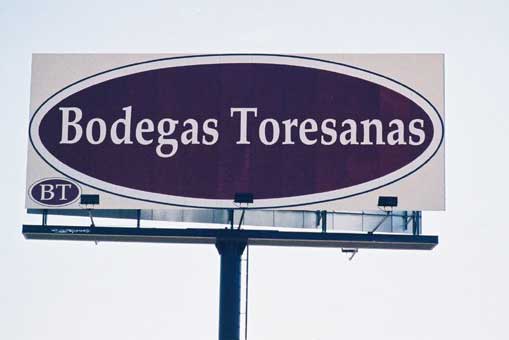
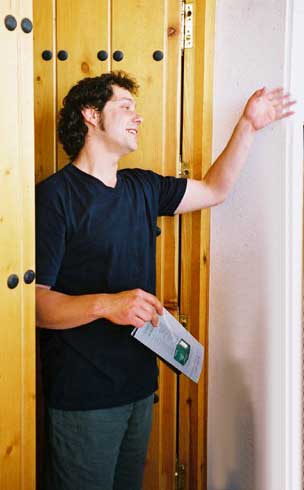 The
Denominacion de Origen of Toro, based around the small town of Toro in the
Zamora province, is a relatively new denominacion, established in 1987.
Toro is at a lower altitude (the vineyards are at about 600m - 700m above
sea level) than the Ribera del Duero, though its climate is similar: a
markedly continental climate, characterised by very low temperatures during
winter and also by the low rainfall (between 350mm and 450mm annually) and
high sunshine. It is a very flat landscape, the vines growning mainly on
sandy, red alluvial soils. Because of the light free-draining
soils, many of the older vines here are ungrafted pre-phylloxera vines.
The soil also retains the heat very well.
The
Denominacion de Origen of Toro, based around the small town of Toro in the
Zamora province, is a relatively new denominacion, established in 1987.
Toro is at a lower altitude (the vineyards are at about 600m - 700m above
sea level) than the Ribera del Duero, though its climate is similar: a
markedly continental climate, characterised by very low temperatures during
winter and also by the low rainfall (between 350mm and 450mm annually) and
high sunshine. It is a very flat landscape, the vines growning mainly on
sandy, red alluvial soils. Because of the light free-draining
soils, many of the older vines here are ungrafted pre-phylloxera vines.
The soil also retains the heat very well. The growing season in Toro is normally around six weeks shorter than the Ribera del Duero, with much earlier ripening. In fact, over-ripeness and high levels of alcohol are becoming a problem for winemakers. The main grape is the Tinta de Toro, another synonym for tempranillo, which develops a much thicker skin in Toro: this leads to more tannin in the wines. You used to be able to sum up Toro wines as high alcohol, high flavour, high colour, as bullish and as unsubtle as the name would suggest (toro means bull in Spanish). Recently, however, winemakers, with the introduction of modern equipment, have been able to tame the alcohol levels, but still retain much of the rustic character. Now there is much interest among the wine press and wine-lovers in Toro, which many see as Spain's next "big thing". Certainly winemakers are flocking to Toro: besides the Sanz family, Alejandro Fernández, (see Pesquera and Condado de Haza above), has bought a 250 hectare former fighting bull ranch outside the village of Vadillo de la Guareña and has planted around 100 hectares of vines; Bodegas Mauro, under Mariano García, the former winemaker of Vega Sicilia (see above) have opened a winery in Toro in the village of San Román, making wines under the San Román name from grapes from existing old vines Tinta de Toro and Garnacha; Vega Sicilia (see above) have also opened in Toro, also in San Román (Bodegas Mauro have grabbed the San Román name, and so Vega Sicilia's Toro wines, the first of which has just (Summer 2004) been released, go under the name Pintias.
The Sanz family are well-known winemakers in Spain, a family business since the 1870s Their new winery in Toro, Bodegas Toresanas, opened in 1998, though Antonio Sanz has had vines here since the early 1980s, and has been making wines in the cooperative bodega at Morales de Toro since 1984. The winery is still not complete: a major setback was a serious fire in June 2002, which destroyed much of the equipment and blew the roof off: the signs of smoke damage were clearly visible.
I was shown round by Ricardo Sanz (see left), the member of the family with responsibility for Bodegas Toresanas. Ricardo is a man of great passion and energy to put it mildly: he was completely buzzing with unnatural energy!
Grapes are hand picked and hand sorted when they arrive in the winery. Fermentation takes place in a mixture of stainless steel and 500 litre barrels. Batonnage takes place after malolactic fermenation is over, but the wines are not pumped over: instead it is done by foot (the winery is on two levels; the lower level, which also holds the 1300-barrel barrel store, is subterranean). Ricardo told me that he is experimenting with different types of barrel, wood, toast, etc. He is also buying in tempranillo from other regions to see how it behaves in comparison to the local Tinta de Toro strain of tempranillo.
Unfortunately, I suffered a nose bleed just before tasting Ricardo's wines, so my senses were a little dulled.
-
2001 Bodegas Toresanas Amant roble
A vino joven, young wine, without oak ageing.100% Tinta de Toro. 25% macération carbonique; 75% traditional vinification. (There is also a Amant Novillo, not tasted, entirely made by macération carbonique.)
A lovely bright young colour. A young, rather alcoholic nose that needs a bit of time to settle down, but already showing smoky brambles with a hint of damson jelly. Nice fruit on the palate with fairly soft tannins. Very big flavours, esecially towards the finish. Really rather good. This is a wine for fairly immediate consumption, certainly not for keeping more than three years. Here in Toro it sells for a bargain €3 a bottle, in the UK it retails for £6 - £7 a bottle.
Very Good Indeed. -
1999 Bodegas Toresanas Orot
A crianza, with 16 months in French oak barrels. Again 100% Tinta de Toro (aka Tempranillo) The name is, of course, Toro backwards.
Plummy, spirity nose with some vanilla. Very attractive. Nice fruit structure. Soft tannins. Good finish. Really opens up on the finish. Although not made to keep, I think this wine will improve with another 18 months or by being clumsily decanted well in advance.
Very Good Indeed. -
2001 Bodegas Toresanas Orot
Same as the 1999 Orot. This wine had only just been bottled - literally, only just bottled: Ricardo grabbed it off the bottling line before opening.
An inferior year to the 1999, but this was also definitely suffering bottle shock; big time bottle shock. A little floral on the nose. Nice fruit, and quite rich and sweet. Rather rough tannins, but of course it has still not finished its crianza-ing.
-
Ricardo told me that there will eventually be a reserva from years like 1999. Through the language barrier and Ricardo's hyperactivity, I couldn't quite grasp whether there would be a 1999 reserva - I think probably not. There won't be any reservas from 2000, 2001 or 2002.
I spent the night of the 29th May 2003 in the beautiful city of Salamanca at the excellent hotel, the Palacio de San Esteban, converted from one wing of the still functioning monastery of San Esteban. We had dinner at the Meson Cervantes a well-regarded restaurant on the first floor overlooking Salamanca's beautiful Plaza Mayor, where we met up with Jorge Banús, the commercial director for Haciendas de Espana, who would be taking us to two of his company's brand new bodegas, the Bodega Zoritas and the Bodega Durius, the next day. The food at the Meson Cervantes was decent solid stuff, nothing special; service was pretty dreadful. We drank:
-
2002 Vina Cantosan, Rueda
OK nose. A bit harsh and astringent. Refreshing initally at least. Fair. -
2001 Enate Somontona
I failed to take a proper note on this: I just recorded that it was OK-ish
The next day, the 30th May 2003, after struggling to escape from the Salamanca one-way system, we again met up with Jorge Banús, he drove on ahead, while we tried to keep up in pursuit of his British Racing Green MG. We stopped first at the Hacienda Zorita, some 12 km north east of Salamanca. This was largely still a building site, as the main building, an old mill and Dominican convent, was being converted into a boutique winery hotel: wine tourism is an important and growing business. The Hacienda Zorita and the Hacienda Unamuno are the home of the Marques de Grinon's Durius project.
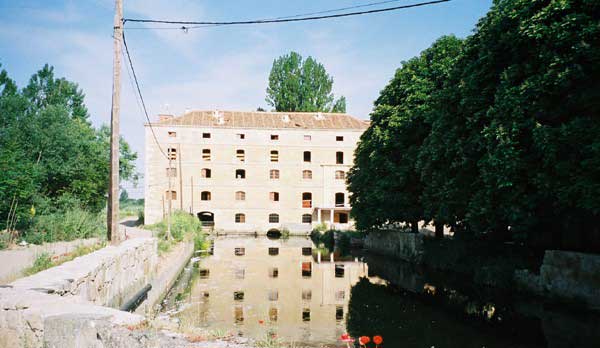
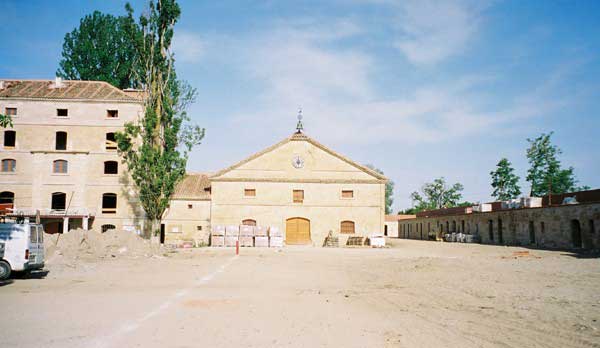
We had a quick look round here, but only the barrel store (see below), for the ageing of Durius wines was complete, so we were quickly on our way to the second of the Durius properties.
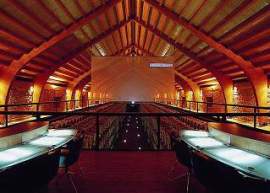
The Hacienda Unamuno is set in around seventy hectares of vineyards and olive trees, and is an even more boutique and exclusive wine hotel (this one was more or less finished when I was there!), with just four rooms in the Italianate building. The Hacienda gets its name from the writer and poet Don Miguel de Unamuno, who described the Arribes del Duero as one of the most beautiful landscapes of Spain.
The Hacienda Unamuno is surrounded by vineyards, planted with five varieties: malbec, tempranillo, syrah, cabernet and there is one hectare of Juan Garcia, a local grape used for red wine. The on-site winery is run by young winemaker Alma Garcia (seen below). The grapes are harvested by hand into 25kg boxes and after destemming, the different varieties are vinfied separately in the temperature-controlled 25,000 litre stainless steel tanks visible in the background. A mixture of French and American oak is used for ageing the wines.

Over a lunch of various local charcuterie and cheeses, followed by a splendid paella and some rather chewy stewed veal, we drank the following wines.
-
2001 Durius Hacienda Durius, Alto Duero
A blend of, principally, Tempranillo with a dash of Juan Garcia, aged for six months in barriques.
Quite young looking. An aromatic, quite spicy nose. Lovely attack. Quite fresh and very clean, with lots of attractive fruit. Quite a spicy feel to it. Excellent finish. Very Good Indeed. -
2001 Durius Hacienda Zorita Tempranillo, Arribes del Duero
This is 100% tempranillo, aged 8 months in oak (though it would be easy to guess that there was some cabernet sauvignon in this). Very smooth, soft, rounded, excellent fruit. Spicy on the finish (largely from the oak, I think). Possibly a little simple. But extremely drinkable and Very Good. -
2000 Principe Alfonso de Hohenlohe, Petit Verdot , Vino de Mesa de Andalucia
From a joint venture between Haciendas de Espana and Prince Aphonse de Hohenlohe in Ronda in Andalucia, some 40km behind Marbella. Made with the assistance of Michel Rolland, this spends 12 months in oak. A lovely, young vibrant dark inky colour. Plummy nose with maybe a bit of vieille prune. Soft, very forward fruit. There are some significantly big tannins on the palate. Nice finish, with more tannins. Excellent fruit after. Good/Very Good. -
1999 Masia Monistrol Vi de Guardia Reserva Especial , Penedes
A cabernet merlot blend that spent 18 months in barrel. Clarified with egg whites, but otherwise bottled unfiltered.
An excellent brambly-blackcurrant nose with nice vanilla toastiness. Lovely attack, which fills very well into a palate full of lovely soft fruit. Very rounded and well honed. The oak is kept very well in check and overall the wine has very good balance. Some tannins appear on the finish. Very Good Indeed. -
1999 Enartis Dominio de Susan , Rioja
A blend of tempranillo, syrah, cabernet, merlot that's spent 18 months in oak. Very attractive plummy colour. A big nose, dominated by raspberry fruit. Lovely rounded attack. There's a lot of fruit and then some good oak and tannins come through. This is nicely knitted together, though perhaps a touch simple. Very Good.
After lunch, for dessert, they produced some gorgeous little aniseed confections, like a cross between a cake (with an almost scone-like texture) and a doughnut. Very yummy but utterly wine-killing!
The Douro Valley, Portugal
Then it was back to the road for the drive over the border into Portugal. The very uppermost reaches of the Douro Valley in Portugal are quite interesting: it is wild, open, quite savage country, deeply cut by the river. What signs of civilisation there once were are rapidly being reclaimed by nature: an old border crossing point is crumbling, and signs of former agriculture (vines, fruit trees, olives) show no sign of continuing to be tended. Indeed there are more than a few completely abandoned terraces. You need to come quite a way into Portugal before habitations and agriculture, predominantly viticulture, become more frequent.
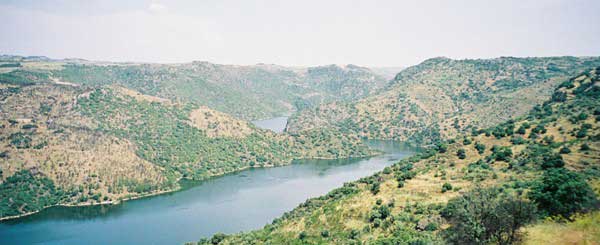 The upper reaches of the Portuguese Douro
The upper reaches of the Portuguese DouroThe most famous product of Portugal's Douro valley is, of course, port. This is not the place to go into depth on the history of port and the method of production: there are several websites out there devoted to port alone. I will direct your attention in particular to Port and Douro Wine Institute (IVDP) which is one of the most comprehensive sites there is, Roy Hersh's growing resource at fortheloveofport.com, the Port Appreciation Site, and the Vintage Port Site (though note that this is run by the Symington family, one of the biggest of the port producers, some of whose ports I taste below at Quinta do Bomfin and at the Graham's Lodge in Vila Nova de Gaia),
But quickly, lest you are completely unfamiliar with port, here is a brief rundown. Port is a fortified (i.e. spirit is added to stop fermentation) red wine produced from up to around thirty varieties, the most common of which are Tinta Roriz (known in Spain as Tempranillo), Tinta Barocca, Tinto Cão, Touriga Nacional, Touriga Franca. It comes only from the Douro Valley in Portugal, which is the oldest denominated region (or appellation contrôlée as the French have it) in the world. Much of the port industry is dominated by non-Portuguese owners - and in fact the majority are British. The vineyards are classified into six quality levels from A to F (the Port Appreciation Site has a good summary of this here) depending on a number of factors, such as exposure to sun, height above sea level etc. Based on the vineyard classification, there are quotas as to how much port can be produced, with the remainder of the grapes being used for table wine. Formerly, the table wine production in the Douro was seen pretty much merely as a way of using up the left over grapes, but increasingly more attention is being paid to the table wines and some great wines are being produced now.
In my view, this property, owned by Cristiano van Zeller (the former owner of Quinta do Noval until it was sold to Axa) and with wines made by the lovely Sandra Tavares, is one of the rising stars of the Douro, both for its ports and its table wines. The Quinta, which has been in Cristiano van Zeller's wife's family for more than 150 years was leased to Smith Woodhouse between 1973 and 1996 and used to contribute to Smith Woodhouse vintage port before van Zeller took over: the first vintage under its own name was the 1996. The Quinta has around ten hectares of vines, all of which are over sixty years old, in a field blend of at least 28 varieties - all of which go into all the wines. The grapes for both the port and the table wines are trodden by foot, which is still practical given the relatively small production. The grapes for the table wines are selected on the basis of their acidity, as a higher acidity is needed for the table wines than for the ports. To fortify the ports, they use brandy from Bordeaux, and Sandra Tavares aims to make ports that can be drunk relatively young, rather than having to live them for thirty years.
Winemaker Sandra Tavares is the Douro's first female winemaker making port, though not the only female winemaker in the Douro (for example, a Spaniard makes wines at Quinta do Cotto). Born of a Portuguese father and a Swiss mother she studied agronomy at Lisbon and oenology at Piacenza, she is married to Jorge Serodio Borge, who is a winemaker at Niepoort. Together Sandra and Jorge make Pintas in their garage: both the table wine and the port of Pintas are rapidly gaining cult status. Sandra also makes wines at her family's estate in Alenquar. In the laboratory at the Quinta, Sandra Tavares led us through the following tasting:
-
Douro Rio Torto 2000 (en magnum)
A deep young purple. The nose is quite bizarre with aniseed and blackberries and very concentrated. On the palate, it's powerful and rich, with intense, concentrated flavours and deep black fruit. Perhaps a touch spirity on the finish, this could probably do with at least five years. Very Good Indeed. -
Douro Rio Torto 2001 (barrel sample)
A very dark ruby colour. The nose is much more closed than the 2000 (though remember, this is a barrel sample), with very concentrated plums. Very full attack. Very smooth and rich. Very spicy on the finish, largely from the tannins, which override the lovely plums and spice flavours. Needs more time obviously, though this is likely to be more approachable sooner than the 2000. Very Good Indeed. -
1999 Vintage Port
Very young and very spirity. There is some fruit on the palate, but it's a bit closed overall. Quite high acidity. Bit strange really, but it was drunk with Sandra and Jorge, whom I'd have expected to spot a dodgy bottle, so it's no more than Good. -
2000 Vintage Port
10,000 bottles were produced. A very concentrated colour. Nice, forward, herby, liquoricey nose with lots of black fruit. Very good on the attack. This has lots of fruit and is really quite nutty too. The spirit is still just a touch harsh on the finish, but that's soon going to integrate I think. There is some nice acidity and an impressive structure. Excellent. -
2001 Vintage Port (barrel sample)
There is blackberry fruit on the nose and some warming spice, but it's really quite closed at the moment. Round and quite fresh on the palate, with lots of fruit. This is an impressive wine. Very Good indeed/Excellent. -
2002 Vintage Port (barrel sample)
2002 was a difficult vintage, Sandra Tavares told me. There is much, much more fruit on the nose and also lots more spirit. This is a very interesting wine, with lots of character and a certain nuttiness. There spirit is still rather loose of course, but this is going to be good stuff. Very Good Indeed. -
Reserve Port
Sandra Tavares told me this wine was produced exclusively for Direct Wines - unfortunately, I didn't press her on whether she meant this particular cuvée, or all the QdVDM "Reserve Port". This one was bottled unfiltered. It has an intense, plummy nose with violets. Rather good on the attack with plenty of fruit. There's quite a lot of spirit evident on the palate, followed up by soft tannins on the finish, where it's clean and fresh. Good/Very Good.
That evening, we dined with Sandra Tavares and Jorge Borge at an old "château" several hundred metres up in the hills on the south side of the Douro, up no less than perilous roads (though we only got held up by one accident on the way). We began in the first floor drawing room with nibbles of grilled homemade chorizo-style sausage and bacalhau fritters to die for, accompanied by the Gloria Branco (see below), before moving into the dining room next door, a room which had not yet been wired up for electricity, so everything was little by candlelight. We had a delicious, simple, creamy vegetable soup, followed by roast smoked pork, accompanied by polenta with smoked pig mixed into it, creamed cabbage and garlicky roast potatoes. Pudding was a yummy creme brulée with strawberries. We drank the following wines:
-
2001 Gloria Douro branco, V. Leite de Faria Vinhos Ltd, Douro DOC
This is a blend of 50% Gouveio and 50% Viosinho, fermented in oak, and then aged in oak for six months. The company was founded by Vicente Leite de Faria in April 2000, continuing a family tradition of winemaking in the Douro valley.
The wine has a dullish nose with a touch of elderflowers. Fresh and light on the palate, with a touch of sweetness. A bit like a still prosecco in fact. Nice aperitif. Very Good. -
2001 Domini, José Maria da Fonseca & Van Zeller, Douro DOC
The two Domini wines are a collaboration between Domingos Soares Franco and Cristianos Van Zeller. The straight Domini is a tank-fermented blend from Rio Torto and Pinhão fruit, that spends 6 months in used oak (French and American) - around 60,000 bottles are produced annually.
The 2001 had a fruity, spirity nose. Very forward on the palate. Simple initially, but it develops well with great fruit and a nice herbaceousness. Very Good + -
2000 Domini Plus, José Maria da Fonseca & Van Zeller, Douro DOC
A more limited production of around 6000 bottles only. This is clearly older and a bit more together than the 2001 Domini, and there is plenty of fruit. Perhaps a bit heavy handed with the oak? Very Good +
For notes on further wines made by Sandra Tavares, see this page.
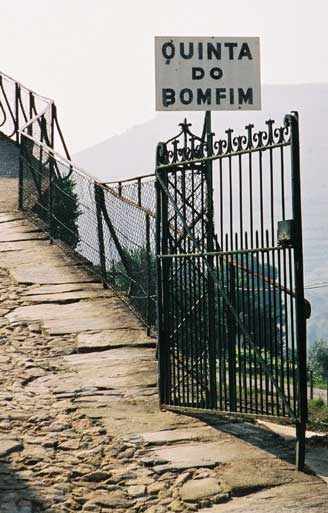 The
Symingtons are one of, if not the biggest player in the port industry, taking in
the big names like Graham's , Dow's, Warre's, Quinta do Vesuvio, Smith
Woodhouse, Quarles Harris and Gould Campbell. Each estate has its own
winemaker. In general, the harvest begins around the 20th September, and
Quinta do Vesuvio is invariably the first to start picking. Typically, the
grapes are pressed (either by foot in the granite lagares typical of the region,
by the robotic lagares invented by the Symingtons or (less commonly) with the
usual sorts of press. Quinta do Vesuvio is entirely foot-trodden.
After pressing, the must is left to ferment for three to four days, when it's
drained off (at Bomfin into large wooden casks) and the aguardiente is added.
The aguardiente is a neutral grape spirit around 77% alcohol approved by the
Casa do Douro, although since government restrictions on the brandy that can be
used were lifted, some winemakers such as Sandra Tavares above are using
brandies from outside Portugal. At Bomfin, the brandy comes from southern
Portugal. A typically sized lagar will normally hold around 50 pipes of
port (1 pipe is 550 litres) and it takes 50 people to tread the grapes in each
lagar. It is becoming increasingly difficult to find locals or Portuguese
from elsewhere in Portugal to do this, and commonly the workforce is now drawn
largely from central and eastern Europe. When treading the grapes, the
team of fifty will spend two hours in regimented systematic treading and then
they get two hours "libertad" (freedom) when the music strikes and they can have
a bit more fun (though still treading the grapes!). In no small part in
response to the problems of finding the workforce to tread the grapes (and of
paying them in an age of minimum wages), the Symingtons developed robotic
lagares in which machines mimic the action of the human foot. The robotic
lagares were invented and developed by the Symingtons, but they have not taken
out a patent pro bono publico. The Symingtons insist the robotic
lagares work well and have been installing them in most of their properties:
Graham's 2000 Vintage Port was robot trod. Unusually, at Bomfin, the port
goes into large white "mammas" (Portuguese for 'boobies' - see the
picture below left), where it stays 5 or
6 months until the spring, when it is moved to the Dow's lodge in Vila Nova de
Gaia.
The
Symingtons are one of, if not the biggest player in the port industry, taking in
the big names like Graham's , Dow's, Warre's, Quinta do Vesuvio, Smith
Woodhouse, Quarles Harris and Gould Campbell. Each estate has its own
winemaker. In general, the harvest begins around the 20th September, and
Quinta do Vesuvio is invariably the first to start picking. Typically, the
grapes are pressed (either by foot in the granite lagares typical of the region,
by the robotic lagares invented by the Symingtons or (less commonly) with the
usual sorts of press. Quinta do Vesuvio is entirely foot-trodden.
After pressing, the must is left to ferment for three to four days, when it's
drained off (at Bomfin into large wooden casks) and the aguardiente is added.
The aguardiente is a neutral grape spirit around 77% alcohol approved by the
Casa do Douro, although since government restrictions on the brandy that can be
used were lifted, some winemakers such as Sandra Tavares above are using
brandies from outside Portugal. At Bomfin, the brandy comes from southern
Portugal. A typically sized lagar will normally hold around 50 pipes of
port (1 pipe is 550 litres) and it takes 50 people to tread the grapes in each
lagar. It is becoming increasingly difficult to find locals or Portuguese
from elsewhere in Portugal to do this, and commonly the workforce is now drawn
largely from central and eastern Europe. When treading the grapes, the
team of fifty will spend two hours in regimented systematic treading and then
they get two hours "libertad" (freedom) when the music strikes and they can have
a bit more fun (though still treading the grapes!). In no small part in
response to the problems of finding the workforce to tread the grapes (and of
paying them in an age of minimum wages), the Symingtons developed robotic
lagares in which machines mimic the action of the human foot. The robotic
lagares were invented and developed by the Symingtons, but they have not taken
out a patent pro bono publico. The Symingtons insist the robotic
lagares work well and have been installing them in most of their properties:
Graham's 2000 Vintage Port was robot trod. Unusually, at Bomfin, the port
goes into large white "mammas" (Portuguese for 'boobies' - see the
picture below left), where it stays 5 or
6 months until the spring, when it is moved to the Dow's lodge in Vila Nova de
Gaia.
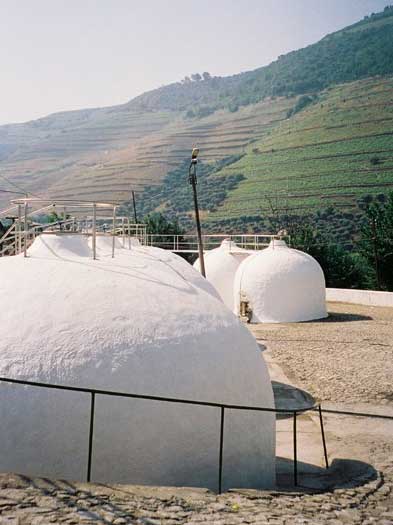 |
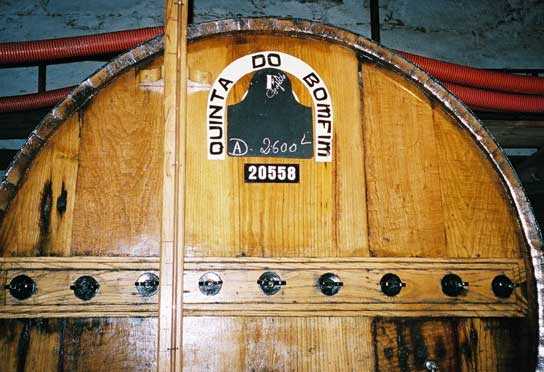 The (A) indicates that aguardiente has been added; the 2600L indicates the cask contains 2,600 litres. |
| The Bomfin mammas |
I found Bomfin an interesting visit, which is more than can be said from the ports we were offered to taste, which were all a bit low-end. On the other hand, it can be useful to try these more entry-level wines without having to buy a bottle!
-
Grahams 6 Grapes (unfiltered ruby)
This is probably cellarable for a while and, as it is bottled unfiltered, can be expected to throw a crust. Lots of soft brambly fruit. Notably sweeter, less elegant, less austere than the Warrior. -
Warres Warrior
Lots of fruit on the nose with a nice scent. This is a solid ruby port with nice fruit and not overly spirity. -
Dows LBV 1997 (filtered)
Dow make an LBV most years, except very poor years like 1993. This has a good nose with lots of character, though less fruit than the two preceding rubies. Very attractive on the attack. A nice elegant port. the fruit comes charging along, delivering dried fruit and nut flavours on the finish. -
Grahams LBV 1997 (filtered)
A rather elegant nose. Very round and fresh on the attack with intense black fruit. Lovely finish. This is impressive, though of the two, I'd prefer the Dow. -
Warres LBV 1992 (bottled 1996) (unfiltered)
This needed decanting. A deep, complex black fruit nose, but rather spirity. Very complex and concentrated on the attack. Develops huge depth with chocolate a hint of mint and pepper. -
Grahams Quinta dos Malvedos 1995
A very floral nose with concentrated black fruit. Very soft attack. Huge fruit on the palate. Rather sweet, which makes it immediately approachable. -
Warres Otima 10 year old tawny
A nutty fruit-cake, drying nose. Soft dry fruit on the palate. A good aperitif, and would work well lightly chilled. -
Dow's 20 year old tawny
A rather lovely colour. Dried fruit and marzipan on the nose. Light and quite fresh on the palate. This is clean and attractive, with very pleasant, crisp, dried fruit flavours. -
Graham's 30 year old tawny
A gorgeous colour. Nutty nose. Mellow soft fruit on the palate with nice caramel hints.
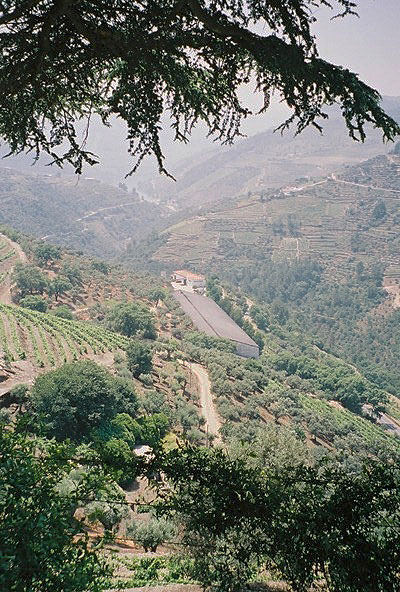
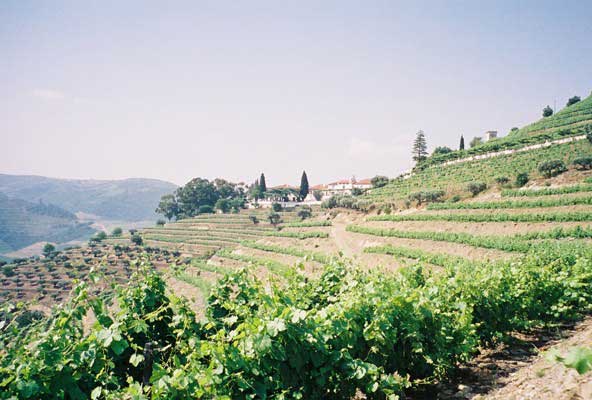 Quinta
do Noval was bought from the Van Zellers in 1993 in 1993 by
Axa Millésimes, (owners of
Disznoko, Suduiraut, Pichon Longueville etc, as well as Noval), and initially
managed for several years by Christian Seely. Axa and Seely introduced a number
of technical improvements from the beginning and started a big re-planting
schedule. By 1996, they had replanted around 35 ha of the original 66 ha estate,
reducing the number of varieties considerably, concentrating on touriga nacional
(now accounting for 50% of all the vines on the estate) and tinto cão. A
large temperature- and humidity-controlled warehouse was built (visible in the
photograph to the left with the black roof) which maintains a constant 18°C and
replaced the lodge in Vila Nova da Gaia: all of Noval's wines have been matured
here since the restrictions saying that the wines had to be exported from Gaia
were lifted. (The bottling plant is off-site, around 12km north of the
Quinta.)
Quinta
do Noval was bought from the Van Zellers in 1993 in 1993 by
Axa Millésimes, (owners of
Disznoko, Suduiraut, Pichon Longueville etc, as well as Noval), and initially
managed for several years by Christian Seely. Axa and Seely introduced a number
of technical improvements from the beginning and started a big re-planting
schedule. By 1996, they had replanted around 35 ha of the original 66 ha estate,
reducing the number of varieties considerably, concentrating on touriga nacional
(now accounting for 50% of all the vines on the estate) and tinto cão. A
large temperature- and humidity-controlled warehouse was built (visible in the
photograph to the left with the black roof) which maintains a constant 18°C and
replaced the lodge in Vila Nova da Gaia: all of Noval's wines have been matured
here since the restrictions saying that the wines had to be exported from Gaia
were lifted. (The bottling plant is off-site, around 12km north of the
Quinta.)
Around 90% of the Noval estate is dedicated to port production: the other 10% to olive oil production and table wines. When Axa took over, Seely also set about increasing the vineyards, on his own admission by spending much time in the bars and cafes of Pinhao, discussing Portuguese football and buying the odd square metres of prime vineyard sites in and around the Noval estate that for whatever reason Noval didn't own. They now have 100 hectares under vine. The fabled Nacional vineyard, with its pre-phylloxera vines, which are replaced from their own cuttings, extends to some 2.5 hectares, directly below the house. If a Nacional port is not released in a particular year, the grapes with go into the classic vintage port.
The geology at Noval is basically schist, and such soil as there is is predominantly schist also. Vines are not so much planted in the Douro Valley, as inserted into holes drilled into the rock! As throughout the Douro, the valley sides are so steep that terraces have had to be cut/blasted into the rock: at Noval the vineyard walls retaining the terraces can reach 8 metres high.
Noval typically harvests late in the season and late in the day: grapes arrive in the winery around 17:30 and are trodden from around 20:00 in the evening. The first treading is apparently a men-only affair. Originally the Quinta had five lagares, but some are now divided so that they can deal with separate blends differently. They also have one robot to work at night to keep the grapes moving. The second team starts treading at 08:30 the next morning and while go through to 17:30. Noval use Portuguese brandy to fortify the wines, including some made from their own pressings.
Within the main Quinta building there is a small chapel, where a priest blesses the new wine and as part of the ceremony, the winemaker is given bunches of flowers which go on the barrels.
Noval also has the Silval estates, which make ports ready for earlier drinking - they start to come round after around five years. They are bottled simply as Silval Vintage Port, not Quinta do Silval, as the wines are not from a single quinta.
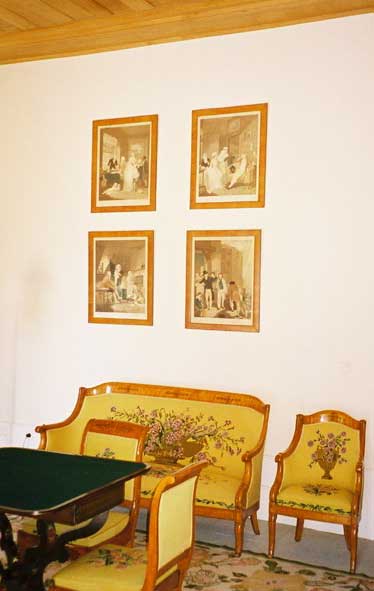
|
Before lunch, a small tasting was laid on in one of the quinta's elegant rooms |
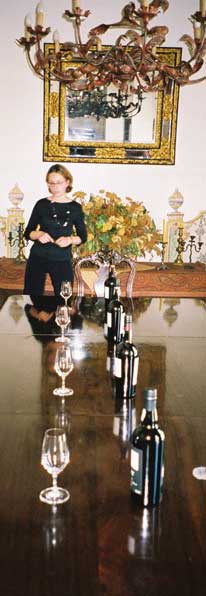 |
|
||
|
||
|
||
|
-
Noval Extra Dry White Port
A very floral, very attractive nose. Extremely dry and not entirely drinkable with pleasure, and not even particularly good once tonic's been added.
-
Corucho 1999, Douro DOC
This is Noval's table wine. A blend of tinta roriz, touriga francesa and tinta barrocca. Quite a porty nose with black fruit aromas. Good soft fruit. Fairly tannic and with a lot of acidity. A decent enough drop with the meal. Good. -
Quinta do Noval Colheita 1974 (served blind)
Lightly chilled tawny. Orangey brown tan colour. Good mix of fresh acid, sweetness, fruit and dried fruit. Very fresh and clean. Lively and quite vibrant.
Bottled 2002. -
Silval 1997 (served blind)
Very dark and young looking, with a hint of purple youth on the rim. The nose is really powerful, with mulberries and violets. Smooth attack. Lots of fruit. Some spirit on the finish. This is very fruit driven, though not oversweet. Quite concentrated and really quite complex. The spirit blows off after a while. Very pleasant to drink now, but I'd give it 5+ years. Very Good Indeed.
For more notes on Quinta do Noval, including four vintages of the fabled and fabulous Nacional, and the 1955, click here.
That evening, I ate in the Rabelo restaurant of the otherwise excellent Vintage House in Pinhão, where I was staying.
As an aperitif, we were served
Taylor's Chip Dry White port
Largely innocuous.For a starter, I chose a dish containing that archetypal Portuguese foodstuff, salt cod (or bacalhao), for which it is said the Portuguese have 365 ways of preparing it. This, a bacalhau and chickpea pancake, was, I think, the 366th, and there's a good reason to stop at 365. This was a rather leaden fritter with very salty bacalhao - and very little of it.
Main course was a leg of kid, supposedly milk-fed. This suffered from being overcooked.
To finish, a tarta de arancia turned out to be a bit like an orange-flavoured sponge pudding cum baba. It was rather stodgy, but had a good taste.
Service was very slow and far from charming. With the meal, we drank:
2001 Quinta Sá de Baixo Malvasia
A dryish nose. Soft fruit. Dry, clean. Pleasant. Good+2000 Gouvyas Reserva, Bago de Touriga
This is a blend of Tinta Barroca, Tinta Roriz and Touriga Francesca made in small quantities by winemaker Luis Soares Duarte. It has a very interesting nose, that's floral and fruity and avoids being too port-like. Quite a fresh feel on the palate. Really rather complex. Quite full, but also very elegant. Very Good Indeed.Quinta do Crasto 1999
Quinta do Crasto is owned by a branch of the van Zeller family; the winemaker was David Baverstock. A fairly deep nose with intense black fruit and a hint of oxidation. Fairly light on the attack, and apparently showing a bit of (premature) age. Nice soft tannins. Clean finish. Fairly good.
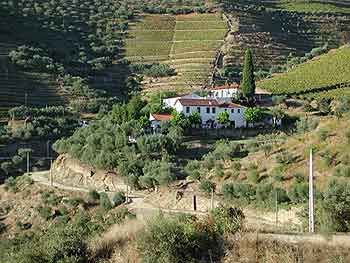 Owned since 1991 by
a Belgian, Dieter Bohrmann, and, when I was there (1st June 2003), Niepoort had
a share in it too, though there has since been a parting of the ways (Niepoort's
Redoma used to be made with Passadouro grapes, but those grapes are now going
into Passadouro reserve wines). We were shown round by the Dutch managers, Jet
Spanjersberg and Ronald Weustink, and Ronald took us through a tasting before a
slap up lunch with Passadouro and Niepoort wines and ports. Jet and Ronald also
run the guest house operation at Passadouro. I didn't stay there, but I bet it's
a lovely place to stay and the prices aren't bad at all.
Owned since 1991 by
a Belgian, Dieter Bohrmann, and, when I was there (1st June 2003), Niepoort had
a share in it too, though there has since been a parting of the ways (Niepoort's
Redoma used to be made with Passadouro grapes, but those grapes are now going
into Passadouro reserve wines). We were shown round by the Dutch managers, Jet
Spanjersberg and Ronald Weustink, and Ronald took us through a tasting before a
slap up lunch with Passadouro and Niepoort wines and ports. Jet and Ronald also
run the guest house operation at Passadouro. I didn't stay there, but I bet it's
a lovely place to stay and the prices aren't bad at all.
The estate covers around 32 hectares, 16 hectares of which are under vines, though in June 2003 they had just obtained a 2 hectare beneficão allowing them to extend production. Until 2002, it had also been possible to use a beneficao from the Vinho Verde or even Dao regions. Most of the vines at Passadouro are old (many 50+ years), although looking from the terraces of Passadouro I could see lots of new plantings belonging to Fonseca across the valley.
In 2003, the winemaking facilities at Passadouro were, to put it politely, charmingly rustic. There are four lagares and a basket press. This was the barrel store at the time:
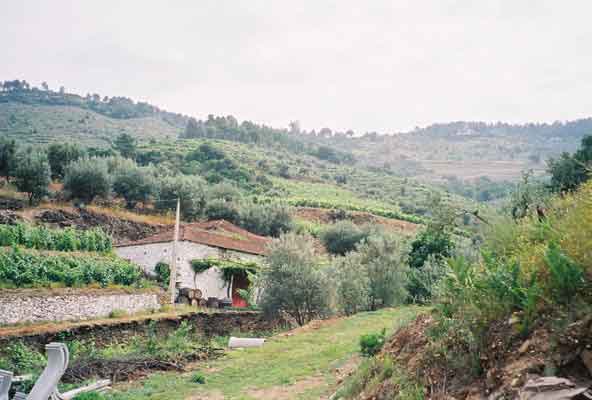
|

|
The grapes are
hand-picked and most are pressed by foot in the lagares. As elsewhere, the
pressing process consists of two hours of strictly regimented pressing, normally
beginning around 8 o'clock in the evening, followed
by one hour of "libertad" when the band plays and the wine flows. In
amongst the usual explanations of the pressing process, I got the interesting
statistic that you need two treaders per pipe. Many of the treaders are now from
central and eastern europe: there were 200,000 Ukrainians working in Portugal in
2003.
I'll just say that I think the labels for the Passadouro ports are pretty
hideous.
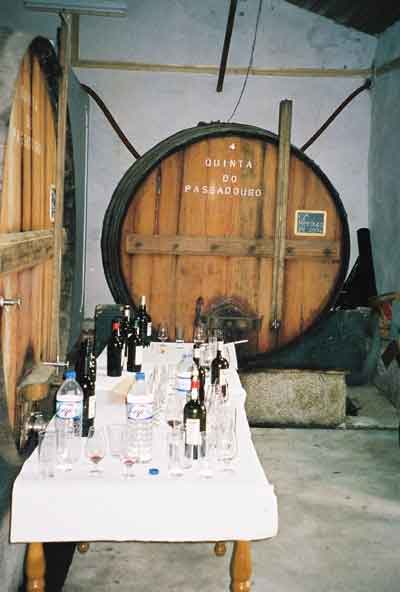 2001
Redoma Branco, Douro DOC, Niepoort
2001
Redoma Branco, Douro DOC, Niepoort
The vineyards for Redoma Branco are all between 400 and 800 metres above sea
level and hence are a lot cooler (especially at night), which means a longer
ripening period. Three of the vineyards are over 100 years old, and the
rest are at least 60 years old. the main variety is rabigato, together
with a significant amount of codega, as well as some other varieties (including
donzelinho, viosinho and arinto, though there is no malvazia fina in the Redoma
branco).
Quite a deep gold. Rather dull nose with some citrus and a light oaking. Light,
refreshing and quite crisp on the palate with an attractive minerality and
decent acidity. By no means a fruit-driven wine, however. Really nice. Very Good
Indeed.
1997 Quinta do Passadouro (table wine)
Dark and quite young. A dullish nose with some deep black fruits and quite
scented as well. Unfortunately it seems a bit flat on the palate. Pleasant,
juicy, and nice easy drinking, but a bit dull. Good/Very Good.
1999 Quinta do Passadouro (table wine)
Very dark and very young looking. A pleasant, rather rustic nose. Decent fruit
and good balance. Nice tannic structure, especially on the finish. Very Good
Indeed.
2000 Quinta do Passadouro (table wine)
Very young appearance and a very bright, vibrant colour, but inky and
impenetrable at the centre. Deep, dark plummy fruit on the nose, and vaguely
reminiscent of Beaucastel. Very good, very forward fruit on the palate. Oddly
spirity at the moment and really this does still need some time to sort itself
out and come together. A bit disunified at the moment. But, assuming it does
sort itself out, this should be Very Good Indeed.
Quinta do Passadouro Ruby Port
A new wine, commercialised for the first time in 2002. Good colour - exactly
what you'd expect of a ruby. Rather good nose with lots of deep plums. Very nice
attack. Round fruit that opens out well. Really quite dry. A rather interesting
and different style for a ruby, perhaps because (unusually for a ruby) it's
bottled unfiltered. Very Good Indeed.
1997 Quinta do Passadouro Late Bottled Vintage
Bottled, unfiltered, after five years. Young and inky appearance. Very pleasant
nose with nice floral notes. Good attack. Fairly complex and well knitted. Very
Good/Very Good Indeed.
1996 Quinta do Passadouro Vintage Port
Showing some medium age in its colour. Nice fruit on the nose, but also some
disjointed spirit. Really quite sweet on the attack. Good fruit. Nice and
rounded. Spirity finish balanced with soft tannins. Nice character. Very Good
Indeed.
2000 Quinta do Passadouro Vintage Port
A vibrant young colour. Good fruit on the nose, with violets and almonds. Quite
forward fruit on the palate. Interesting flavours - really quite crisp and clean
flavours. Good tannins on the finish. A notable lack of spiritiness, which makes
a nice change. I'd happily drink this now. Very Good Indeed.
2001 Quinta do Passadouro Vintage Port (barrel sample)
A barrel sample, cunningly hidden in a Passadouro Vinho Tinto 1995 bottle, which
was momentarily confusing!
Very dark and intense colour. Very attractive nose with violets and liquorice.
Sweet attack. Very nice fruit balanced by fairly soft tannins. Lovely on the
finish, with no jarring spiritiness. A very interesting wine with lots of
character. Very Good Indeed/Excellent.
NV Niepoort 10 years old tawny port
(Bottled 2002) A very pale, brickish orange colour. Good nose
with a nice balance for fresh and dry fruit. Very attractive on the
palate, with lovely balance. This has a nicely counterpointed fresh/dry
fruit nuttiness. Very Good+
NV Niepoort 20 years old tawny port
A lovely, pale rosewood colour. Round soft fruit. Very nice
balance though a bit marred by heavy spirit on the finish. Good/Very Good.
NV Niepoort 30 years old tawny port
(Bottled 2001) An attractive pale caramel colour and an old fruit-cake
nose. This is a very fine wine: clean, neat and remarkably fresh.
Excellent.
-
A miscellaneous Douro wine drunk at the Restaurant Merceario
-
2000 Quinta do Cachao branco, Douro DOC
A fairly deep yellow-gold colour. Fragrant and quite fresh on the nose. Attractive attack. Some body and a nice acidity. Very clean. Simple but good. Blind, you might tend to think more towards vinho verde, such is its crisp freshness. Very Good+
-
-
Grahams Port
3rd June 2003
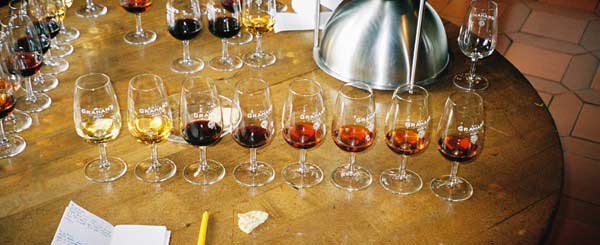
From left to right:
-
Grahams Tico Dry White
A fairly elegant nose. Quite attractive. It has some of the overtones of a fino sherry. Dry and clean. Not bad. -
Grahams Fine White
A much sweeter nose and much, much more sweet on the palate. OK-ish. -
Grahams Late Bottled Vintage 1996
Bottled (filtered) in 2002. A rather subdued nose with a bit of spirit. Soft, rather sweet attack. There is a touch of tannins, followed by a bit of spirit on the finish. 1996 LBVs continue to fail to impress. Good. -
Grahams 6 grapes
This has a nice nose, with some violets and dark plums. Good, clean flavours and not too sweet. Nice round flavours and a good fruit character. Good finish. Very Good (+) -
Grahams 10 year old tawny
A lovely colour - like a pale ruby (the photograph above against the wooden tabletop doesn't really do it justice). A nice nose too, with fairly fresh fruit and some oxidation and nuttiness developing. Good attack with nice fruit immediately evident. A bit spirity on the middle, and the spirit unfortunately becomes just a little too dominant on the finish. Good+ -
Grahams 20 year old tawny
There's remarkably little difference in colour between this and the preceding 10 year old tawny. A good fruitcake nose with a hint of molasses. Very good attack. This has a very nice balance of fresh and dry fruit, some oxidised notes and nuttiness on the palate. Again, there's a bit of spirit on the finish, but this time, it's in check. Very Good/Very Good Indeed. -
Grahams 30 year old tawny
(Bottled 2003) A lovely polished oak colour. The nose is slightly dull, and I wonder if this bottle might possibly be a bit dried out from being open a while (it was a bottle open for general tastings in the Graham's lodge). Actually, it's very nutty on the nose. Smooth, fruit-cake flavours, and perhaps a bit cloying. But very enjoyable. Very Good Indeed. -
Grahams 40 year old tawny
(Bottled 2003) This was a much darker colour than the 30-year old, as would be expected: tawnies leech colour out into the wood for the first 10, 20, 30 years, but after about 40 years in barrel, the colour leeches back into the wine. The nose is much richer, with more wood and complex dried fruit and nuts. Marvellously complex and mouthfilling. There is some good fruit that appears in the mouth, though the wine finishes with a slightly tart, rich fruitcake.
The assistant in Grahams helpfully explained the lot coding system they use: on this bottle of 40 year old tawny, the Lot Number L3013 was shown. The first digit indicates the year, so 2003, the next three digits the day of bottling. So this was bottle was bottled on day 13 of 2003, i.e. January 13th 2003.
-
Text and photographs © Copyright Andrew Stevenson, 2003 (except where noted)
Last updated: 12 July 2007 18:52